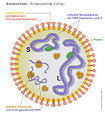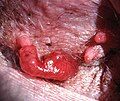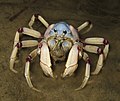Portal talk:Biology/Proposed
Instructions
- If there's an article you'd like to see featured (and note that as per previous discussion, only articles of considerable quality will be accepted), add it to the bottom of the corresponding "proposed queue" (there are queues for selected article, selected picture, and selected biography). The link is given at the bottom of this section. If there are any articles in the proposed queue that you think should not be selected, put them back in the "repository" section, giving a reason in your edit summary.
- Once five days have passed without dispute after adding an article to the proposed queue, it moves up to the "agreed queue". Unless very serious reasons can be brought forward, the article is set in stone for being shown on the page when its turn in the queue comes. Updates of the portal content should not be done more frequently than every seven days.
- Articles suggested by important current events may be slipped in ahead of the queue, with the queue remaining unchanged.
- Proposed queues may be rearranged in any way; agreed queues may be rearranged only in order to create a sensible combination of content. For instance, an article on developmental biology might be paired with an image of a foetus. Such pairs should be marked so to ensure they can be maintained even if one article is postponed due to a current event.
Agreed queue
Main article
Biography
Featured picture
Proposed queue
Main article
- Dürer's Rhinoceros - something a little different
- History of biology
- Flight feather
- Immune system
- Whale song
- Javan Rhinoceros
Biography
August Weismann (GA status pending)
Paul Ehrlich (pending translation)
Featured picture
Proposed themes
Taxonomy and systematics
- SA: Molecular phylogenetics
- SB: Carolus Linnaeus(pending GA status)
- SP: Image:Bufo bufo couple during migration(2005).jpg
Antioxidants
- SA: Polyphenol antioxidant (pending GA status) antioxidant
- SB: Linus Pauling (pending GA status)
- SP: Image:Alaska wild berries.jpg
- SA:
Microorganisms What is life?
Viruses
SA: Virus
A virus (from the Latin virus meaning toxin or poison) is a sub-microscopic infectious agent that is unable to grow or reproduce outside a host cell. Virus diseases inflict a heavy illness and economic burden on humans and animals and can devastate agricultural crops. Each viral particle, or virion, consists of genetic material, DNA or RNA, within a protective protein coat called a capsid. Their shape varies from simple helical and icosahedral (polyhedral or near-spherical) forms, to more complex structures with tails or an envelope. Viruses infect cellular forms of life and are grouped into animal, plant and bacterial viruses.
It has been argued whether viruses are living organisms. Some consider them non-living as they do not meet the criteria of the definition of
SB: Frank Macfarlane Burnet
Sir
From the mid-1950s, he worked extensively in immunology and was a major contributor to the theory of
Burnet left the Walter and Eliza Hall Institute in 1965, he continued to work at the University of Melbourne until his official retirement in 1978. During his working life he wrote 31 books and monographs and more than 500 scientific papers. Burnet played an active role in the development of public policy for the medical sciences in Australia and was a founding member, and later the president, of the Australian Academy of Science. He was the most highly decorated and honoured scientist to have worked in Australia.[1] For his contributions to Australian science, he was made the first Australian of the Year in 1960, and in 1978 a Knight of the Order of Australia. He was recognised internationally for his achievements: in addition to the Nobel, he received the Lasker Award and the Royal and Copley Medals from the Royal Society, honorary doctorates, and distinguished service honours from the Commonwealth and Japan.
-
translated version of this
Repository
Main article
sequence alignment, natural selection, invasive species
Biography
Featured picture
-
Slightly gross, but great educational value!
-
DONE
-
DONE
-
DONE
-
DONE
-
DONE
-
DONE
-
DONE
-
DONE
-
DONE
- ^ Fenner, F. 1987. Frank Macfarlane Burnet. Historical Records of Australian Science 7:39–77.

























